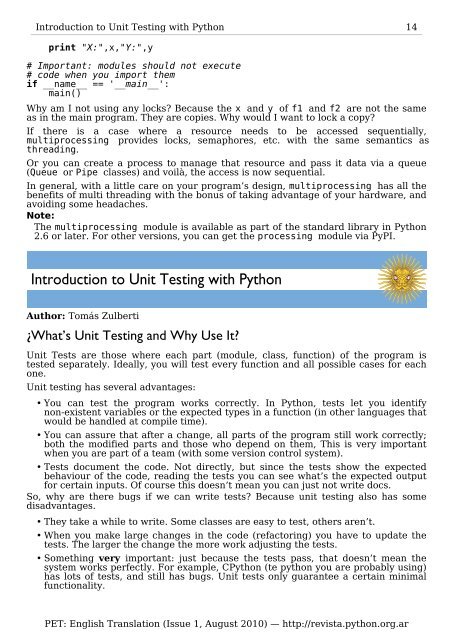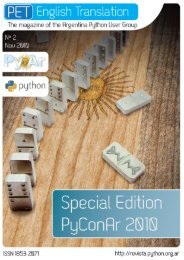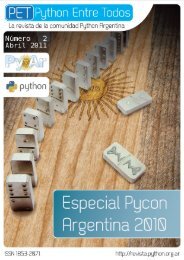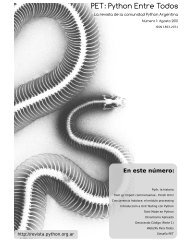A4 portrait - PET: Python Entre Todos - Python Argentina
A4 portrait - PET: Python Entre Todos - Python Argentina
A4 portrait - PET: Python Entre Todos - Python Argentina
You also want an ePaper? Increase the reach of your titles
YUMPU automatically turns print PDFs into web optimized ePapers that Google loves.
Introduction to Unit Testing with <strong>Python</strong> 14<br />
print "X:",x,"Y:",y<br />
# Important: modules should not execute<br />
# code when you import them<br />
if __name__ == '__main__':<br />
main()<br />
Why am I not using any locks? Because the x and y of f1 and f2 are not the same<br />
as in the main program. They are copies. Why would I want to lock a copy?<br />
If there is a case where a resource needs to be accessed sequentially,<br />
multiprocessing provides locks, semaphores, etc. with the same semantics as<br />
threading.<br />
Or you can create a process to manage that resource and pass it data via a queue<br />
(Queue or Pipe classes) and voilà, the access is now sequential.<br />
In general, with a little care on your program’s design, multiprocessing has all the<br />
benefits of multi threading with the bonus of taking advantage of your hardware, and<br />
avoiding some headaches.<br />
Note:<br />
The multiprocessing module is available as part of the standard library in <strong>Python</strong><br />
2.6 or later. For other versions, you can get the processing module via PyPI.<br />
Introduction to Unit Testing with <strong>Python</strong><br />
Author: Tomás Zulberti<br />
¿What’s Unit Testing and Why Use It?<br />
Unit Tests are those where each part (module, class, function) of the program is<br />
tested separately. Ideally, you will test every function and all possible cases for each<br />
one.<br />
Unit testing has several advantages:<br />
• You can test the program works correctly. In <strong>Python</strong>, tests let you identify<br />
non-existent variables or the expected types in a function (in other languages that<br />
would be handled at compile time).<br />
• You can assure that after a change, all parts of the program still work correctly;<br />
both the modified parts and those who depend on them, This is very important<br />
when you are part of a team (with some version control system).<br />
• Tests document the code. Not directly, but since the tests show the expected<br />
behaviour of the code, reading the tests you can see what’s the expected output<br />
for certain inputs. Of course this doesn’t mean you can just not write docs.<br />
So, why are there bugs if we can write tests? Because unit testing also has some<br />
disadvantages.<br />
• They take a while to write. Some classes are easy to test, others aren’t.<br />
• When you make large changes in the code (refactoring) you have to update the<br />
tests. The larger the change the more work adjusting the tests.<br />
• Something very important: just because the tests pass, that doesn’t mean the<br />
system works perfectly. For example, C<strong>Python</strong> (te python you are probably using)<br />
has lots of tests, and still has bugs. Unit tests only guarantee a certain minimal<br />
functionality.<br />
<strong>PET</strong>: English Translation (Issue 1, August 2010) — http://revista.python.org.ar
















